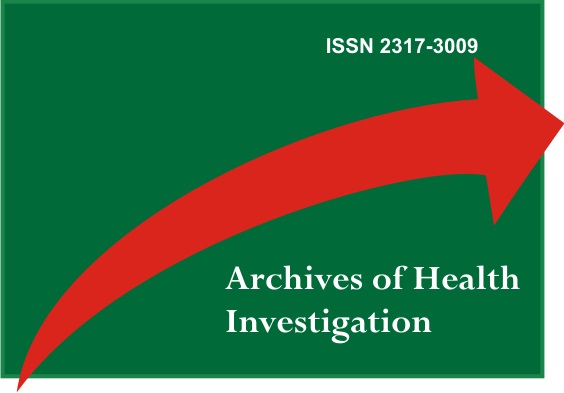Tratamiento de microdoncia con ortodoncia y restauración indirecta: caso clínico
DOI:
https://doi.org/10.21270/archi.v10i8.5447Palabras clave:
Microdoncia, Tratamiento de Ortodoncia Preprotésica, Cerámica, Restauración IndirectaResumen
Objetivo: Este caso clínico tiene como objetivo presentar el tratamiento de la microdoncia del diente 35 mediante ortodoncia preprotésica, seguida de reanimación con restauración indirecta. Caso clínico: paciente de 21 años con microdoncia en el diente 35, con corona distalizada y vestibular. Además, el diente 34 estaba girovertido con un diastema mesial. Se utilizó una mecánica de ortodoncia con arco segmentado para centrar el diente 35 en el reborde alveolar, cerrar el diastema en mesial del diente 34 y corregir su giroversión. Para la lingualización del diente 35 se realizó un pliegue de primer orden (in set) en la arcada y, para la mesialización, se utilizó un resorte helicoidal abierto entre los dientes 35 y 36. Se utilizó un resorte helicoidal cerrado para delimitar el movimiento del diente 35 para mesial. La fuerza aplicada por el resorte abierto para la mesialización del diente 35, fue transmitida al diente 34, a través del resorte cerrado, resultando en su mesialización; esto, cerró el diastema entre los dientes 33 y 34 y corrigió la giroversión. Posteriormente, se realizó la preparación coronaria con puntas de diamante 1014 y 3146 y la corona provisional se realizó en resina acrílica. Para el sistema cerámico se utilizó IPS ™ e.max Press. La corona de cerámica se cementó mediante la técnica adhesiva, seguida de fotopolimerización durante 40 segundos en cada cara del diente. Conclusión: Se puede concluir que la reanimación de un microdent debe ser la primera opción de tratamiento. Sin embargo, puede ser necesario un tratamiento de ortodoncia preprotésico.
Descargas
Citas
Ufomata D. Microdontia of a mandibular second premolar. Oral surg oral med oral pathol. 1988;655:637-38 .
Kaste SC, Hopkins KP, Jones D, Crom D, Greenwald CA, Santana VM. Dental abnormalities in children treated for acute lymphoblastic leukemia. Leukemia.1997;11(6): 792-96.
Pegoraro LF, Do Valle AL, Pegoraro TA, Corotti KMV, Vidotti HA. Resolution of complex esthetic problems in abnormal anterior teeth: A clinical report. J Prosthet Dent. 2014;112(2): 94-8.
Pedersen LB, Clausen N, Schrøder H, Schmidt M, Poulsen S. Microdontia and hypodontia of premolars and permanent molars in childhood cancer survivors after chemotherapy. Int J Paediatr Dent. 2012;22(4):239-43.
Brook A, Jernvall J, Smith R, Hughes T, Townsend G. The dentition: the outcomes of morphogenesis leading to variations of tooth number, size and shape. Aust Dent J. 2014;59(Suppl 1):131-42.
De Freitas Brianezzi LF, Brondino BM, De Campo Chaves G, Ishikiriama SK, Furuse AY. Interdental papilla formation after diastema closure. Gen Dent. 2017;65(6):e13.
Yassin SM. Prevalence and distribution of selected dental anomalies among saudi children in Abha, Saudi Arabia. J Clin Exp Dent. 2016;8(5):e485-90.
Saratti CM, Krejci I, Rocca GT. Multiple diastema closure in periodontally compromised teeth: How to achieve an enamel-like emergence profile. J Prosthet Dent. 2016;116(5):642-46.
Nihill P, Lin LY, Salzmann LB, Stevens S. Esthetic overdenture for a patient with possible Seckel syndrome. Spec Care Dent. 1996;16(5):210-13.
Morkmued S, Clauss F, Schuhbaur B, Fraulob V, Mathieu E, Hemmerlé J et al. Deficiency of the SMOC2 matricellular protein impairs bone healing and produces age-dependent bone loss. Sci Rep. 2020;10(1):14817.
Patroni S, Cocconi R. From orthodontic treatment plan to ultrathin no-prep CAD/CAM temporary veneers. Int J Esthet Dent. 2017; 12(4):504-22.
Meshram P, Meshram V, Palve D, Patil S, Gade V, Raut A. Comparative evaluation of microleakage around Class V cavities restored with alkasite restorative material with and without bonding agent and flowable composite resin: An in vitro study. Indian J Dent Res. 2019;30(3):403-7.
Kleverlaan CJ, Feilzer AJ. Polymerization shrinkage and contraction stress of dental resin composites. Dent Mater. 2005;21(12):1150-57.
Heintze SD, Rousson V, Hickel R. Clinical effectiveness of direct anterior restorations - A meta-analysis. Dent Mater. 2015;31(5):481-95.
Etman MK, Woolford MJ. Three-year clinical evaluation of two ceramic crown systems: A preliminary study. J Prosthet Dent. 2010; 103(2):80-90.
Heintze SD, Albrecht T, Cavalleri A, Steiner M. A new method to test the fracture probability of all-ceramic crowns with a dual-axis chewing simulator. Dent Mater 2011;27(2):e10-9.
Manso AP, Carvalho RM. Dental Cements for Luting and Bonding Restorations: Self-Adhesive Resin Cements. Vol. 61, Dent Clin North Am.2017;61(4):821-34.
Yoshida K, Tanagawa M, Atsuta M. In-vitro solubility of three types of resin and conventional luting cements. J Oral Rehabil. 1998;25(4):285-91.


